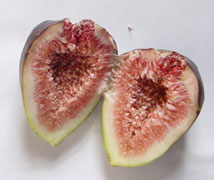


Home
Flowers &
Indoor Plants
Fruits & Nuts
Ornamentals
Vegetables
Special Topics
Resources
Glossary

 |
What about it? The fig tree is yet another attractive accent plant with delicious fruits that cannot be grown in most parts of New York! Only the warmest parts of New York, such as New York City and Long Island, have consistent crops of fig, and even these locations require a protected location. The "fruit" of the fig is not a fruit at all; it is a receptacle for a collection of flowers that grow inside. In wild figs, these flowers are pollinated by a tiny wasp that gets into the flesh through a small opening. The fig tree has smooth gray bark and handsome green, deeply lobed leaves. Although it can get as tall as 25-30 feet, most gardeners prune it to a more manageable height or grow the fig in containers. Northern gardeners often move these containers to a more protected location for winter. What is it used for?The fig is commonly eaten fresh and can be used as a filling in baked goods. Dried figs are a real treat - intensely sweet, and a familiar ingredient in fig newtons! Where does it grow? How do we grow it? The fig does not appreciate cold temperatures at all, and may suffer injury at temperatures much below 15-20 degrees F. The fruit requires several dry, warm months for good fruit development The fig is not very demanding of soil conditions, and in fact, may perform better on poor or adequate soils than nutrient-rich ones. Gardeners should not add nitrogen unless the trees are not putting on much new growth at all. Figs, like most fruit crops, do require good drainage. Figs are propagated through cuttings or layerings. Containers are the easiest way for New Yorkers to grow figs. What are its primary problems? Figs are prone to nematode attacks. They feed on the roots and deprive the plants of needed nutrients. How do we harvest and store them? Mature trees are heavy bearers, and produce as much as 35 pounds of fruit. The fruit is harvested as it colors from green to brown, when the inside is sweet and soft. Enjoy them right away or allow to dry out slightly and store in a dry place for a short period of time.
© Copyright, Department of Horticulture, Cornell University. |



